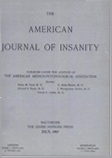AMPHETAMINE (BENZEDRINE) SULFATE AS A CORRECTIVE FOR THE DEPRESSION OF SEDATIVE MEDICATION IN EPILEPSY
Abstract
Amphetamine ( benzedrine) sulfate, (5-30 mgm.) was given to 58 epileptic patients with toxic manifestations as a result of increased anti-convulsant medication, the latter consisting mainly or in part of phenobarbital in all but one case, (receiving mebaral alone).
The toxic effects of the anti-convulsant medication consisted of drowsiness, ataxia, irritability, aggressiveness, anorexia, vertigo, nystagmus and tremor.
Amphetamine (benzedrine) sulfate was notably of value in combating the drowsiness (64.2 per cent of cases); and secondarily of value in relieving ataxia, irritability, aggressiveness and anorexia, associated with the drowsiness.
Amphetamine was effective in 39 cases, ineffective in 18 cases. When effective, amphetamine was constantly necessary in 18 patients, and only temporarily necessary (7 days to 2 months) in 21 patients.
In itself, amphetamine (benzedrine) sulfate did not affect the incidence of epileptic seizures.
By counteracting toxic effects amphetamine (benzedrine) sulfate made it possible, in many cases, to reduce seizures by giving adequate anti-convulsant medication, and in this respect proved of appreciable importance as an adjunct in the therapy of epilepsy.
Access content
To read the fulltext, please use one of the options below to sign in or purchase access.- Personal login
- Institutional Login
- Sign in via OpenAthens
- Register for access
-
Please login/register if you wish to pair your device and check access availability.
Not a subscriber?
PsychiatryOnline subscription options offer access to the DSM-5 library, books, journals, CME, and patient resources. This all-in-one virtual library provides psychiatrists and mental health professionals with key resources for diagnosis, treatment, research, and professional development.
Need more help? PsychiatryOnline Customer Service may be reached by emailing [email protected] or by calling 800-368-5777 (in the U.S.) or 703-907-7322 (outside the U.S.).



